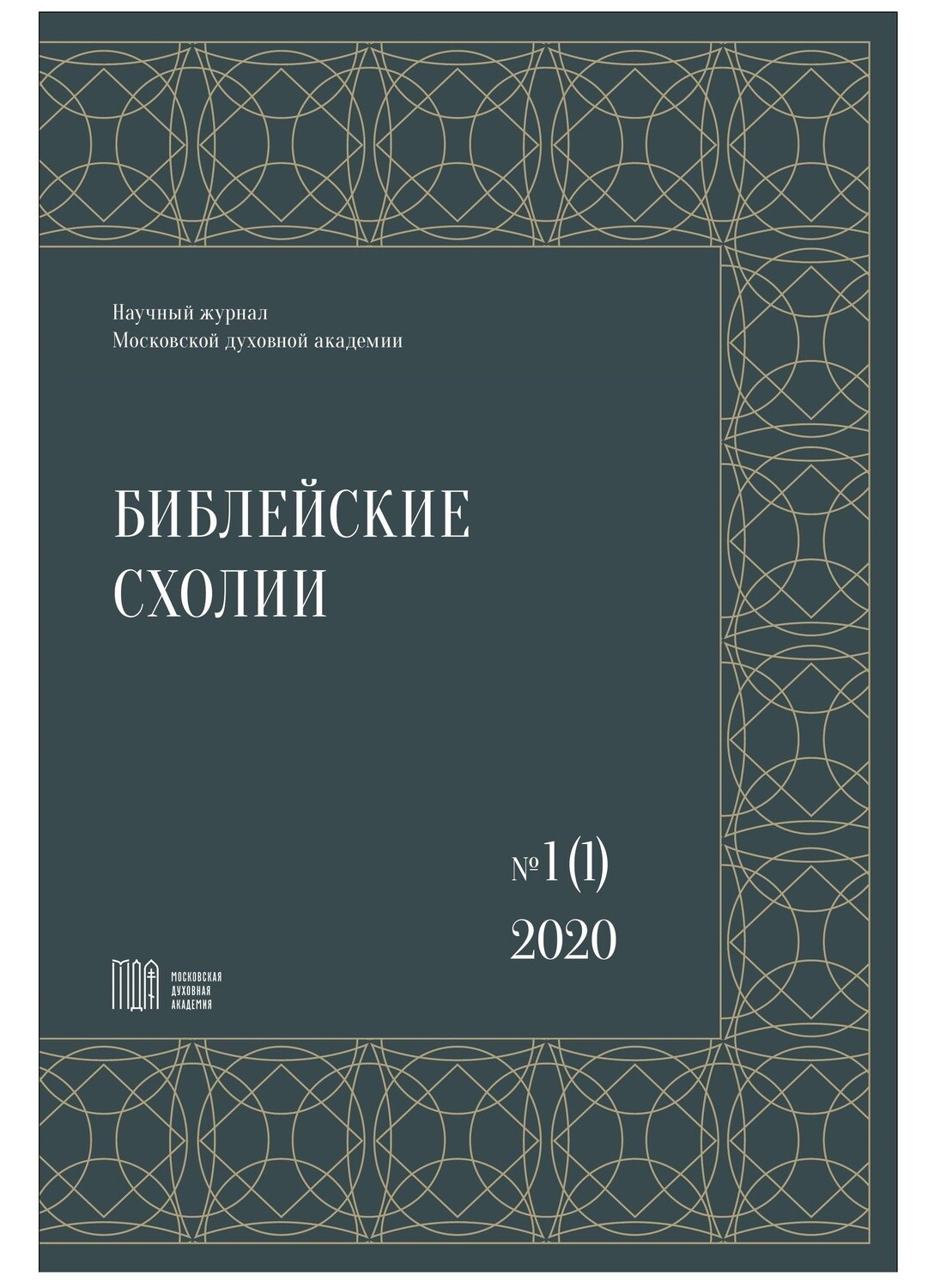David as the New Moses in Theology of the Books of Paralipomenon
DOI:
https://doi.org/10.31802/BSCH.2020.1.1.009Keywords:
The Bible, the Holy Scriptures of the Old Testament, Books of Chronicles, Ancient Israel, the Chronicler, the prophet Moses, king David, new Moses, biblical theology, the Temple in Jerusalem, the Tabernacle, the Tent of MeetingAbstract
This article is devoted to one of the important theological concepts of the books Paralipomenon - the image of king David as the new Moses. The purpose of the article is to identify the characteristic features that indicate the development of this theological idea. For this purpose the author considers several episodes from the Chronicler's narration. These episodes include: the genealogies of the Israeli tribes (1 Chr. 2-9); David's transference and establishment of the Ark in Jerusalem (1 Chr. 13:15-16); David's census, which results in the determination of the place for the future Temple (1 Chr. 21); Solomon's sacrifice at Gibeon (2 Chr. 1), which is directly related to the subsequent construction of the Temple by Solomon (2 Chr. 2-7). These fragments show that the whole story of the Chronicler about the reign of David and Solomon is focused on the process of establishing a new cult system of Ancient Israel, the apogee of which is the construction of the Temple in Jerusalem. The inspirer and the organizer represented by King David. The author of the publication comes to the following conclusion: for the Chronicler David is the true founder of the new cult system of Ancient Israel, which became the direct heir to the ancient cult traditions of the era of Moses. David freely modifies and supplements the many precepts of Moses, and all subsequent kings, beginning with Solomon, maintain and regulate all temple services according to the precepts of David. In addition, drawing parallels between the construction of the Tent of Meeting and the construction of the Jerusalem Temple, the Chronicler strengthens the continuity between Ancient Israel and the generations of witnesses of the construction of the second temple.
Downloads
References
Biblia Hebraica Stuttgartensia / hrsg. K. Elliger und W. Rudolph. 5. Auflage. Stuttgart: Deutsche Bibelgesellschaft, 1997.
French Bible de Jérusalem (1973).
New American Standard Bible (1995).
Septuaginta / hrsg. A. Rahlfs. 2. Auflage. Stuttgart: Deutsche Bibelgesellschaft, 1979.
Библия. Книги Священного Писания Ветхого и Нового Завета. Синодальный перевод. М.: Изд. Московской Патриархии, 2013.
Библия. Современный русский перевод. М.: РБО, 2011.
Исторические книги Священного Писания Ветхого Завета (Четыре книги Царств, две книги Паралипоменон, книги Ездры, книга Неемии и Эсфирь) / пер. с евр., подстрочн. примеч. М. Гуляева. Киев: Тип. И. А. Давиденко, 1866.
Велльгаузен Ю. Введение в историю Израиля / пер. с нем. Н. М. Никольского. СПб.:Тип. Ю. Н. Эрлих, 1909.
A Hebrew and English Lexicon of the Old Testament with an Appendix Containing the Biblical Aramaic / ed. by F. Brown, S. R. Driver and Ch. A. Briggs. Oxford: Clarendon Press, 1907.
Dillard R. B. 2 Chronicles. Waco (TX): Word Books, 1987.
Driver S. R. An Introduction to the Literature of the Old Testament. Edinburg, 1913. P. 315.
Eissfeldt O. The Old Testament: An Introduction, Including the Apocrypha and Pseudepigraphaand Also the Works of Similar Type from Qumran: The History of the Formation of the Old Testament. New York, 1965. Р. 540.
Finkelstein I. The Archaeology of Israelite Settlement. Jerusalem: Israel Exploration Society, 1988.
Hertzberg H. W. Mizpa // ZAW. 1929. Bd. 47. S. 161-196.
Hicks J. M. 1 and 2 Chronicles. Joplin (MO): College Press Publishing Company, 2001.
Holladay W. A Concise Hebrew and Aramaic Lexicon of the Old Testament. Grand Rapids (MI):Eerdmans Publishing Company, 1971.
Hooker P. K. First and Second Chronicles. Louisville (KY); London; Leiden: Westminster John Knox Press, 2001.
Japhet S. I and II Chronicles. London: SCM Press, 1993.
Jeon J. The Priestly Tent of Meeting in Chronicles: Pro-Priestly or Anti-Priestly? // Journal of Hebrew Scriptures. 2018. Vol. 18. P. 1-15.
Johnstone W. 1 and 2 Chronicles. Vol. 1. Sheffield: Sheffield Academic Press, 1997.
Kalimi I. Reshaping of Ancient Israelite History in Chronicles. Winona Lake (IN): Eisenbrauns,2005.
Knoppers G. I Chronicles 1-9: А New Translation with Introduction and Commentary. New York: Doubleday, 2003.
Levin Y. Who Was the Chronicler's Audience? A Hint from His Genealogies // JBL. 2003. Vol. 122.P. 244.
Miller J. M., Hayes J. H. A History of Ancient Israel and Judah. London: SCM Press, 1999.
Rudolph W. Chronikbücher. Tübingen, 1955.
S. X.Schley D. G. Shiloh: A Biblical City in Tradition and History // JSOTS. 1989. Vol. 63. P. 26, 161.
Schniedewind W. М. The Chronicler as an Interpreter of Scripture // The Chronicler as Autor /ed. by M. P. Graham and S. L. Mckinzie. Sheffield: JSOT Press, 1999. Р. 158-180.
Street J. M. The Significance of the Ark Narrative: Literary Formation and Artistry in the Bookof Chronicles. New York: Peter Lang Publishing, 2009.
Welch A. C. The Work of Chronicler: Its Purpose and its Date. London: Oxford University Press, 1939.
Williamson H. G. M. 1 and 2 Chronicles. Grand Rapids (MI): Eerdmans, 1982.
Williamson H. G. M. The Temple in the Books of Chronicles // Templum Amicitiae: Essayson the Second Temple Presented to Ernst Bammel / ed. by W. Horbury. Sheffield: JSOTPress, 1991. P. 15-31
Downloads
Published
How to Cite
License

This work is licensed under a Creative Commons Attribution-ShareAlike 4.0 International License.






